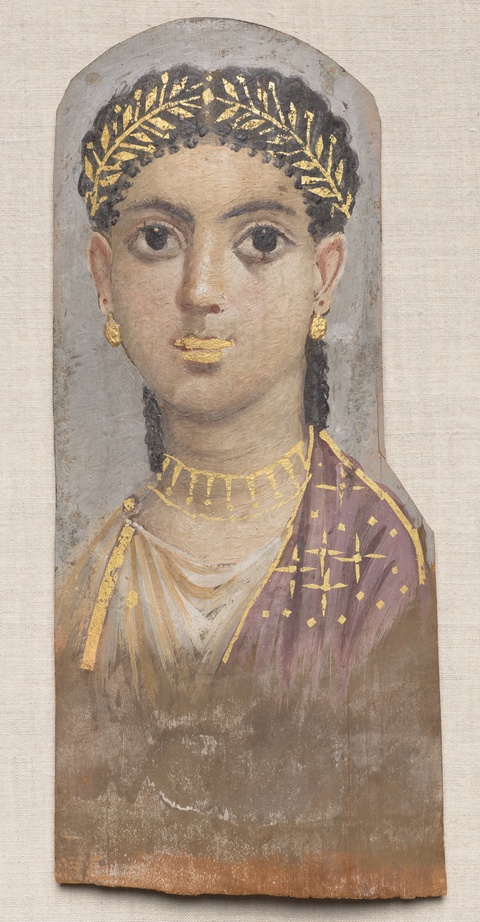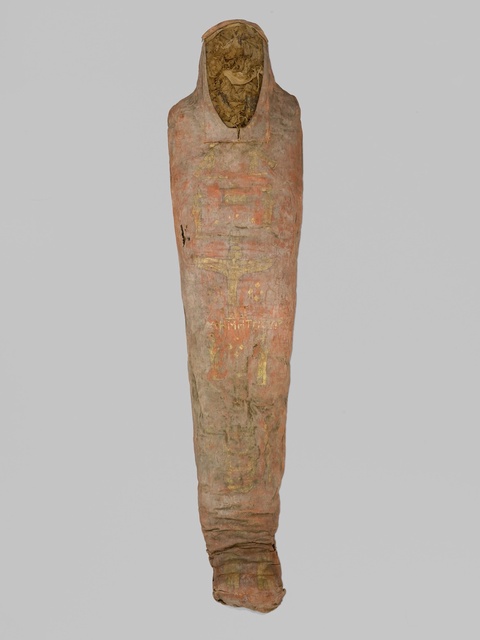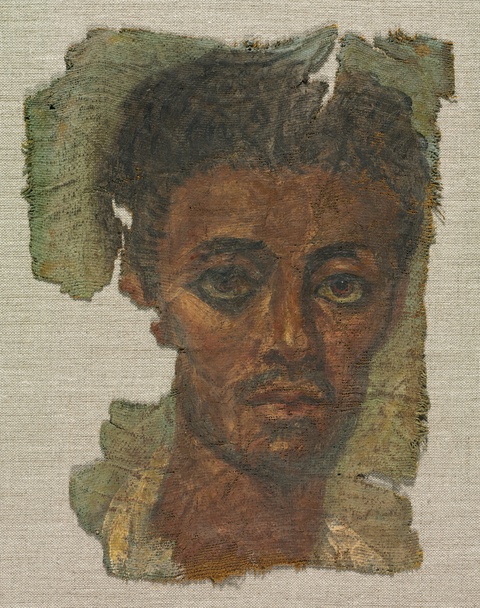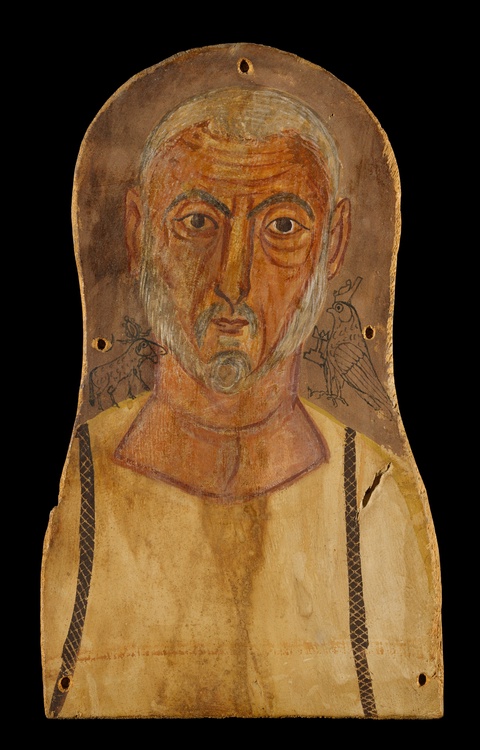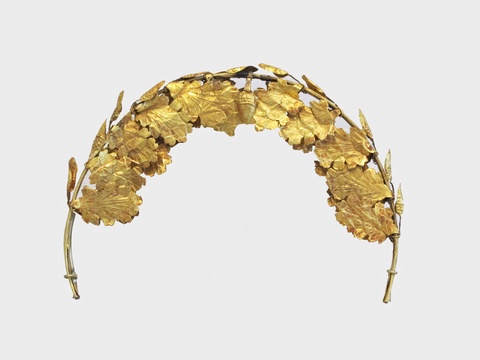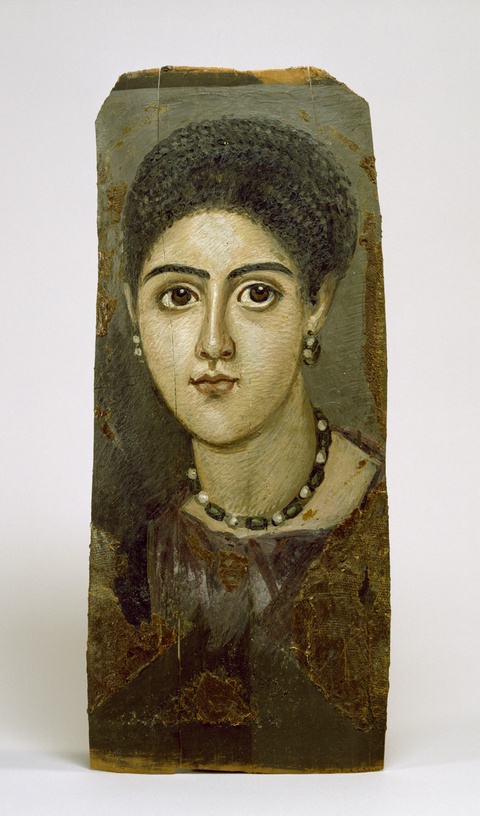Fayum Portraits
By Reina Gattuso•July 2022•13 Minute Read
Funerary portraits from Egypt’s Roman Imperial period are startlingly lifelike. Artists used shading and realistic details to create unique representations of local elites. The Fayum (or Faiyum) mummy portrait tradition fused Egyptian mummification practices with Greco-Roman portraiture to preserve their subjects for eternity.
Introduction
A beautiful, bearded man implores the viewer with enormous eyes, wisps of sweat-damp hair clinging to his forehead. A wreathed girl with a delicate, curled fringe stares at the viewer, her lips gilded bright gold. A baby-faced young boy with cropped hair half-smiles into eternity.
Egypt, Portrait of the Boy Eutyches, 100–150 CE, Roman Period. The Metropolitan Museum of Art.
Each of these people is the subject of a Fayum portrait. Fayum portraits are a form of funerary art. They emerged in the first century CE during Roman imperial rule in Egypt, in the region now called Faiyum1, and remained customary until the third century CE. They were usually rendered in tempera or encaustic on wood, and attached on top of the wrappings of the mummified person’s face. These portraits mostly depict an elite, Greco-Egyptian class who enjoyed high status in the Roman-administered city of Arsinoë in what is now the Faiyum Governorate.
Egypt, Woman with Earrings, 100–150 CE, Roman Period. The Brooklyn Museum.
Art historians know of 900 examples of these portraits held in collections worldwide. Art dealers, archaeologists, and unscrupulous European looters found most of them around the Faiyum region in the 19th and 20th centuries. Many have uncertain provenance.
In the 1800s and early 1900s, Western art historians didn’t know what to make of these portraits. Scholars of Roman history labeled them Egyptian. Scholars of Egyptian history labeled them Greco-Roman.2 These binary academic classifications failed to capture the true complexity of the ancient (or, indeed, modern) Mediterranean. In reality, Fayum portraits are a syncretic form, merging Egyptian and Greco-Roman art and funerary practices. They reflect the cosmopolitanism of both Roman and Egyptian history.
Since the 2010s, scholars have expressed renewed interest in Fayum portraits. The APPEAR project brought together academics from international institutions, who have analyzed about a third of the known portraits. This intensified study came at a politically significant moment of increased Middle Eastern and African refugees in the Mediterranean. European and American powers used, and continue to use, the racist and historically incorrect “clash of civilizations” argument to justify brutal treatment of these refugees. It remains morally urgent to question the colonial categories that continue to shape Euro-American understandings of North Africa.
The African and Mediterranean context of Fayum portraits challenges scholars to rethink colonial categories of art history. Their startling intimacy invites viewers to imagine the lives of human beings nearly two millennia ago.
Preserving the Dead
Fayum portraits resulted from both Egyptian and Greco-Roman beliefs about death. The ancient Egyptians, Greeks, and Romans all believed in some kind of afterlife and took steps to make sure their kin could reach it.
Fayum portraits unite two different forms of symbolic immortality. Mummies preserve an individual’s body, while portraits immortalize how they appeared in life.
Egypt, Portrait of a Man with a Mole on His Nose, 130–150 CE, Roman Period. The Metropolitan Museum of Art.
Egyptian Mummification Practices
The first ancient Egyptian mummifications were probably accidental results of Egypt’s arid climate. Ancient Egyptians likely started intentionally mummifying around 2600 BCE. The practice continued until Roman times.3
Mummification was important to ancient Egyptians because they believed that the soul or spirit lived in the body. They felt the need to preserve the body so that the soul could enjoy eternal life.4
Priests used drying salts to cure the body and organs, then wrapped both in linen. They interred the body in a sarcophagus and kept the organs either in canopic jars or within the mummy’s body.5
At the end of the burial, a priest performed a ceremony called the Opening of the Mouth. This supposedly opened the deceased person's senses to the afterlife, allowing the person to eat and speak through their spirit.6 7
The gilded lips on this Fayum portrait of a young girl represent the glory of the eternal akh, a kind of spirit only possessed by those who had been virtuous in life.8 The gilded lips may also evoke the magical Opening ceremony. Gilded lips are rare in Fayum portraits.9
Among Greco-Egyptians in the Roman period, Fayum portraits replaced cartonnage masks. Embalmers inserted the portraits into the wrappings around the face or tied them on top of the mummy’s head.
Roman and Greek Death Practices
Ancient Greeks and Romans both believed that community members must perform funerary rituals to help the dead reach the underworld. These included burying or cremating the body and offering libations.12 13
Portraiture was an important part of elite ancient Roman funerary practices. Upper class Roman patriarchs commissioned a mask of themselves before death.14 15 The family then kept the mask among those of other honored ancestors in a family shrine. Romans carried these masks in processions honoring their ancestors and flaunting their lineages to gain political credibility.16
After the Roman Empire conquered Egypt from the Hellenistic Ptolemaic Dynasty in 30 CE, Roman rulers and settlers brought their cultural practices to Egypt.17
Posing for Eternity
Most people who sat for Fayum portraits were from the Greco-Egyptian community. They descended from Greek settlers who migrated during the Ptolemaic Dynasty and intermarried with local Egyptians. They absorbed many Egyptian customs, including mummification and the worship of Egyptian and syncretic Greco-Egyptian deities.
While the community considered itself Greek, Roman authorities considered them Egyptian. However, their Greek culture did grant them higher status in imperial Roman society.18
Displays of Wealth and Status
Only the wealthy could afford mummification in ancient Egypt, and this continued through the colonial period. Scholars can tell that the sitters for funerary portraits were wealthy because of the costly materials used to make the portraits. A subject’s array of jewelry and dress also help indicate their status. The woman depicted in the portrait here, for example, is depicted wearing two necklaces, precious earrings, and a gilded wreath.
Egypt, Portrait of a Young Woman with a Gilded Wreath, 120–140 CE, Roman Period. The Metropolitan Museum of Art.
Art historians theorize that wealthier subjects favored portraits painted with expensive encaustic, while less wealthy subjects commissioned portraits with more affordable tempera.19
Mortality and Aging
The subjects of Fayum portraits represent a range of ages, from children to the elderly.
Egypt, Portrait of an Elderly Lady with a Gold Wreath, 100–125 CE, Roman Period. The Metropolitan Museum of Art.
Because so many of the portrait subjects are youthful, art historians were initially uncertain whether artists painted Fayum portraits while the sitters were alive or after they died. Art historians had theorized that subjects commissioned and hung the portraits in their homes until death. Some Fayum portraits do show signs of having been previously framed.20
More recently, however, scholars associated with the APPEAR project have used CT scans to identify the age of mummies. They’ve found that mummies died around the same age as their corresponding portraits, suggesting that most of the portraits were completed after death.21
Young people in Fayum portraits indicate high mortality rates in the ancient world. They are often depicted tenderly, such as a young boy with flowers in his hair, symbolizing eternal life.
Egypt, Boy with a Floral Garland in His Hair, 200–230 CE. The Brooklyn Museum.
This sitter is depicted with a fuzzy upper lip, indicating he was an adolescent. Interestingly, the line under the boy’s eye may be from an infection that was surgically treated.22
Egypt, Portrait of a Youth with a Surgical Cut in one Eye, 190–210 CE, Roman Period. The Metropolitan Museum of Art.
Ancient Egyptians had sophisticated medical practices. Their standards of cleanliness were unrivaled in Europe until the 19th and 20th centuries.23
Creating Realism
Ancient Egyptian and Greek portraits tended to idealize their subjects. Roman portraiture was unique in its “warts and all” approach to the individual.24 Some scholars theorize that Romans developed such a realistic portraiture tradition due to their funerary mask practice.25 Greco-Egyptians then adapted this realistic portraiture tradition for their own ritual use.
Materials
Artists painted some Fayum portraits on cartonnage and some on linen.
However, the majority of Fayum portraits are painted on wood, most of which was imported.26 This gives us an idea of the wide trade networks throughout the Roman Empire that elite Greco-Egyptians had access to.
To paint portraits with encaustic, painters mixed beeswax and pigment, sometimes with oil and resin to vary the texture. Painters used encaustic while warm, and then heated the results to blend.27 This created subtle, lifelike gradations of skin tone. Layering of encaustic gave the final portrait an appearance of depth, as in the portrait of a man below.28
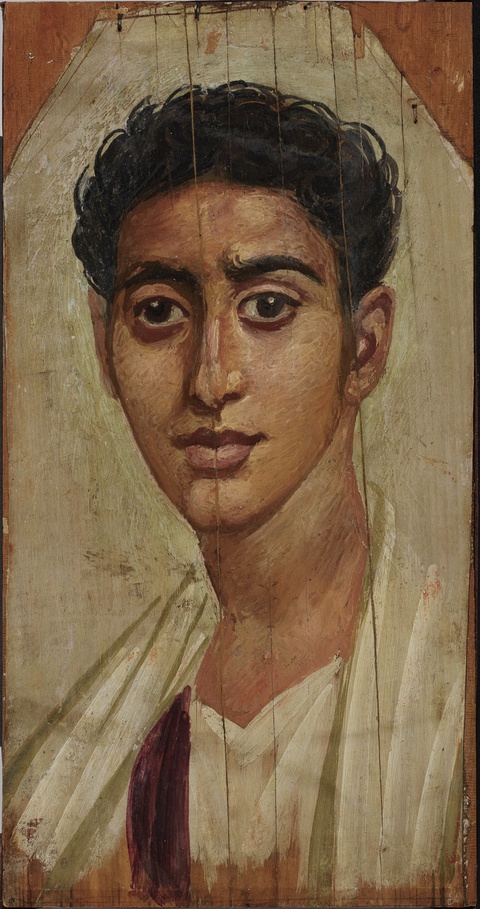
Fayum portrait painters mixed animal glue with pigment to make tempera. Tempera produced slightly chalkier effects, as demonstrated in this portrait of a man depicted with Egyptian gods sitting on each of his shoulders.29
Fayum portrait artists used both local and imported pigments. Artists frequently used Egyptian blue.30 Scholars have also found a manufactured red pigment that workshops had sourced from Spain.31
Gilding was another important technique. Artists applied thin sheets of gold to decorate portrait elements like jewelry, wreaths, and backgrounds. Gilding enhanced the realism of sitters’ finery, and communicated the wealth and status of the portrait subject.
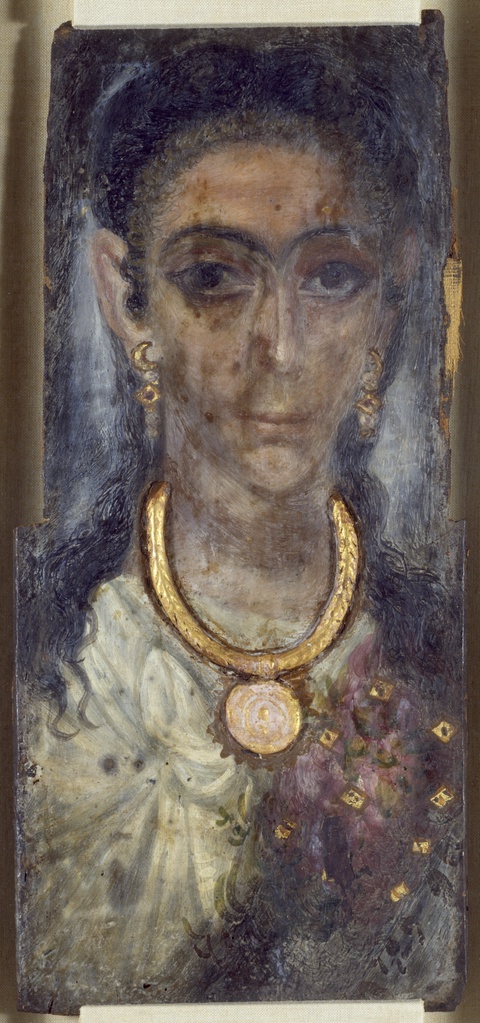

Portrait subjects frequently wore wreaths of leaves and flowers. Ancient Greeks and Romans associated wreaths with military victory and eternal life.32
Ancient Egyptians also wore leaf and flower collars while attending funerary ceremonies. Ancient Egyptians associated flowers and floral motifs with fertility and rebirth.33
Realism
Fayum artists used individual details and shading to create strikingly realistic likenesses. Portrait painters incorporated details representing both the individual and their era. For example, this young woman wears an elaborate braided hairstyle, typical of the reign of Roman Emperor Trajan (98-117 CE). She wears a unique pearl and emerald necklace.
Fayum portrait painters also achieved a sense of lifelikeness through their use of light and shadow. In the painting of the young woman, above, the artist or workshop used highlights on the forehead, chin, and cheeks, and shadows under the chin and eyes, to communicate a sense of depth.
In the portrait of a man below, the bright highlights on the man’s forehead, cheeks, and upper lip contrast with the shading around his eyes and the texture of his brows and beard. The strands of his hair across his forehead appear damp, as though he’s sweating in the heat. His slightly parted lips make the viewer feel as though he could, at any moment, speak.
Egypt, Portrait of a Thin-Faced Man, 140–170 CE, Roman Empire. The Metropolitan Museum of Art.
In Fayum portraits, the sitters’ features are regularly spaced, as though the painters were following a formula or grid. This potentially allowed artists to produce large quantities of portraits.34 35
Painters also enlarged subjects’ eyes relative to real human faces.36 This helped create the intense gazes that grip us today with a sense of individuality and immediacy.
Egypt, Portrait of a Young Woman in Red, 90–120 CE. The Metropolitan Museum of Art.
This curly-haired woman’s eyes are quite large compared to the rest of her face. They are winged by disproportionately large bottom lashes, perhaps as a painter’s trick to further enlarge the eyes.
Egypt, Portrait of a Thin-Faced, Bearded Man, 160–180 CE. The Metropolitan Museum of Art.
This man’s large eyes are emphasized with dark violet shading on the eyelids and below the eyes. A dark line on the upper lid may represent kohl. The artists used white highlights to create a liquid, lucent look on the brown corneas.
The “Oldest Modernist Paintings”
When Europeans began uncovering Fayum portraits in the 19th century, they were shocked by their realism. Today, commentators point out that the paintings’ use of color and shading resemble those of Renaissance Europe. Others have called them the “oldest modernist paintings” due to their emphasis on individuality.
Of course, realism and individualism are not better approaches to art than any others. Valuing art more highly or calling it more sophisticated or advanced just because of its similarity to modern European painting betrays an inherently colonial mindset.
Fayum portraits were developed by Egyptian, Greek, and Roman people on African soil. They thus remind us that many of the intellectual and creative traditions Eurocentric scholars claim to be uniquely modern or Western have origins, influences, or parallels beyond Europe. Fayum portraits are just one of many examples of the cosmopolitanism of the ancient Mediterranean. They should inspire us to challenge the false but persistent binary of “the West and the rest.”
Reina Gattuso is a content writer on the Curationist team, and an independent journalist covering gender and sexuality, arts and culture, and food. Her journalism connects analysis of structural inequality to everyday stories of community, creativity, and care. Her work has appeared at Atlas Obscura, The Washington Post, Teen Vogue, The Lily, POPSUGAR, and more. Reina has an MA in Arts and Aesthetics (cinema, performance, and visual studies) from Jawaharlal Nehru University in New Delhi, India, where her research focused on sexuality in Hindi film. She writes and teaches writing to high school students in New York City.
Citations
Faiyum is the most common spelling in English of the region; Fayum is the most common spelling in English of the art form.
Gotthardt, Alex. “Unraveling the Mysteries of Ancient Egypt’s Spellbinding Mummy Portraits.” Artsy, 8 April 2019, https://www.artsy.net/article/artsy-editorial-unraveling-mysteries-ancient-egypts-spellbinding-mummy-portraits. Accessed 20 April 2022.
“Egyptian Mummies.” Smithsonian, https://www.si.edu/spotlight/ancient-egypt/mummies. Accessed 20 April 2022.
“Egyptian Mummies.”
“Egyptian Mummies.”
“Egyptian Mummies.”
“Mortuary Practices of Ancient Egypt: The Egyptian Soul.” University of South Florida, http://myweb.usf.edu/~liottan/theegyptiansoul.html. Accessed 20 April 2022.
“Funerary Portrait of a Young Girl.” Cleveland Museum, https://www.clevelandart.org/art/1971.137. Accessed 20 April 2022.
“Funerary Portrait of a Young Girl.”
“The Function of a Mummy Mask.” Egypt at the Manchester Museum, 5 September 2012, https://egyptmanchester.wordpress.com/2012/09/05/the-function-of-a-mummy-mask/. Accessed 20 April 2022.
“Cartonnage.” Wikipedia, https://en.wikipedia.org/wiki/Cartonnage. Accessed 20 April 2022.
“Roman Portraiture.” Wikipedia, https://en.wikipedia.org/wiki/Roman_portraiture. Accessed 20 April 2022.
Johnstone, Sarah Iles. “Afterlife: Greek and Roman Concepts.” Encyclopedia, 2005, https://www.encyclopedia.com/environment/encyclopedias-almanacs-transcripts-and-maps/afterlife-greek-and-roman-concepts. Accessed 20 April 2022.
Rose, Brian and Marianna Lovink. “Recreating Roman Wax Masks.” Expedition Magazine, 2014, https://www.penn.museum/sites/expedition/recreating-roman-wax-masks/. Accessed 20 April 2022.
“Roman Portraiture.”
Trentinella, Rosemarie. “Roman Portrait Sculpture: Republican through Constantinian.” The Metropolitan Musuem of Art, October 2003, https://www.metmuseum.org/toah/hd/ropo/hd_ropo.htm. Accessed 20 April 2022.
Wasson, Donald L. “Roman Egypt.” World History Encyclopedia, 24 October 2016, https://www.worldhistory.org/Roman_Egypt/. Accessed 20 April 2022.
“Fayum Mummy Portraits.” Wikipedia, https://en.wikipedia.org/wiki/Fayum_mummy_portraits. Accessed 20 April 2022.
“Unraveling the Mysteries of Ancient Egypt’s Spellbinding Mummy Portraits.”
Thompson, David L. Mummy Portraits, J. Paul Getty Museum, 1982, https://www.getty.edu/publications/resources/virtuallibrary/0892360380.pdf. Accessed 20 April 2022.
“Unraveling the Mysteries of Ancient Egypt’s Spellbinding Mummy Portraits.”
“Portrait of a Youth with a Surgical Cut in One Eye.” The Metropolitan Museum of Art, https://www.metmuseum.org/art/collection/search/547768. Accessed 20 April 2022.
Mark, Joshua J. “Egyptian Medicine.” World History Encyclopedia, https://www.worldhistory.org/Egyptian_Medicine/. Accessed 20 April 2022.
“Roman Portraiture.”
“Roman Portraiture.”
Cartwright, Caroline R. “Understanding Wood Choices for Ancient Panel Painting and Mummy Portraits in the APPEAR Project through
Scanning Electron Microscopy.” Mummy Portraits of Roman Egypt: Emerging Research from the APPEAR Project, 2020, https://www.getty.edu/publications/mummyportraits/part-one/2/. Accessed 20 April 2022.
“Understanding Wood Choices for Ancient Panel Painting and Mummy Portraits”
“Encaustic Painting.” Britannica, https://www.britannica.com/art/encaustic-painting. Accessed 20 April 2022.
“Fayum Mummy Portraits.”
Jane L. Williams et al. “Defining a Romano-Egyptian Painting Workshop at Tebtunis.” Mummy Portraits of Roman Egypt: Emerging Research from the APPEAR Project, 2020, https://www.getty.edu/publications/mummyportraits/part-two/14/. Accessed 20 April 2022.
“Unraveling the Mysteries of Ancient Egypt’s Spellbinding Mummy Portraits.”
Carruthers, Emily. “The Ancient Origins of the Flower Crown.” Getty, 4 May 2017, https://www.getty.edu/news/the-ancient-origins-of-the-flower-crown/. Accessed 20 April 2022.
“A Toast to Life, Death, and Rebirth.” Cooper Hewitt, 26 April 2014, https://www.cooperhewitt.org/2014/04/26/a-toast-to-life-death-and-rebirth/. Accessed 20 April 2022.
Jevon Thistlewood et al. “A Study of the Relative Locations of Facial Features within Mummy Portraits.” Mummy Portraits of Roman Egypt: Emerging Research from the APPEAR Project, 2020, https://www.getty.edu/publications/mummyportraits/part-one/10/#fnref:1. Accessed 20 April 2022.
“A Study of the Relative Locations of Facial Features within Mummy Portraits.”
Reina Gattuso is a content writer on the Curationist team, and an independent journalist covering gender and sexuality, arts and culture, and food. Her journalism connects analysis of structural inequality to everyday stories of community, creativity, and care. Her work has appeared at Atlas Obscura, The Washington Post, Teen Vogue, The Lily, POPSUGAR, and more. Reina has an MA in Arts and Aesthetics (cinema, performance, and visual studies) from Jawaharlal Nehru University in New Delhi, India, where her research focused on sexuality in Hindi film. She writes and teaches writing to high school students in New York City.

